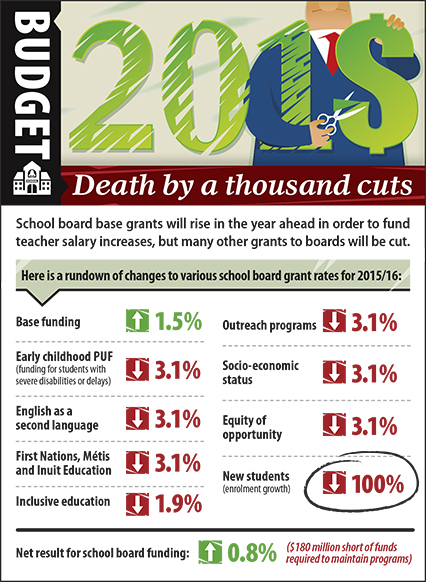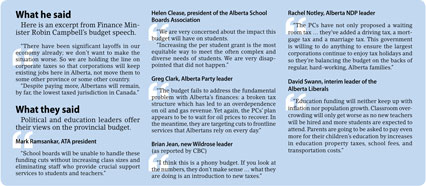Page Content
Modest increase in base funding is offset by other rate cuts and no funding for growth
The recently announced education budget will have a dramatic impact on supports and services for students in Alberta’s public education system. While school board funding will rise by $45 million in 2015/16, it is $180 million short of the funds required to maintain service levels from this school year. Many grants were cut by more than three per cent, and enrolment growth of 12,000 additional students will not be funded.
“School boards will be required to find efficiencies and productivity improvements to reduce their non-teaching costs by three per cent,” said Finance Minister Robin Campbell. “We recognize that school board reductions will be challenging in the face of increasing enrolment —which will not be funded but still must be accommodated.”
 ATA President Mark Ramsankar says this budget will put a significant strain on classrooms.
ATA President Mark Ramsankar says this budget will put a significant strain on classrooms.
“There is no way to shield students from the impacts of these cuts,” says Ramsankar. “Supports for students will erode, class sizes will grow and programs will be eliminated.”
A large number of specific school board grants targeting high-needs areas will be reduced next year. Inclusive education grants will be cut by 1.9 per cent and Program Unit Funding (PUF) for early-childhood students with severe disabilities and delays will be cut by 3.1 per cent. A 3.1 per cent cut is also being applied to grants for English as a second language, First Nations, Métis and Inuit education, socio-economic status and equity of opportunity grants.
“Unfortunately, these cuts will hit our most vulnerable students the hardest,” said Ramsankar. “Issues of inadequate support for students with special needs, English language learners and our First Nations students are already well documented — it will only worsen next year.”

Class sizes will grow; teaching positions protected
 In media interviews, Education Minister Gordon Dirks acknowledged that it is going to be a difficult year ahead and predicted that class sizes will likely grow by about 1.5 students this fall, but his expectation is that current teaching levels will not be reduced. The minister directed school boards that no reduction in classroom-based teaching positions are to be made unless the board is experiencing declining enrolment.
In media interviews, Education Minister Gordon Dirks acknowledged that it is going to be a difficult year ahead and predicted that class sizes will likely grow by about 1.5 students this fall, but his expectation is that current teaching levels will not be reduced. The minister directed school boards that no reduction in classroom-based teaching positions are to be made unless the board is experiencing declining enrolment.
An email sent from deputy minister Lorna Rosen to school board superintendents on budget day said that “with an overall funding increase, school boards are required to maintain all classroom-based teaching positions.” It went on to say that, “The department will monitor school boards’ May 2015 budget submission closely to ensure this direction has been followed.”
 Campbell said in his budget speech that funding increases for boards are meant to “protect teaching positions and allow government to honour the existing collective agreement.” But he added that funding in other areas would be reduced, in order to accommodate teaching salaries.
Campbell said in his budget speech that funding increases for boards are meant to “protect teaching positions and allow government to honour the existing collective agreement.” But he added that funding in other areas would be reduced, in order to accommodate teaching salaries.
Ramsankar says that although the promise to seek funding for the 2013 legislated settlement was technically fulfilled, it involved a fair amount of “fancy math.”
The base instruction and class size reduction grants have been separated into two components for next year. Class size grants and 89 per cent of the base grant have been identified as supporting teacher compensation and have been given a two per cent increase, whereas any other base funding has been flagged as “non-teacher compensation” and has been reduced by three per cent.
“The government has clearly worked to honour the letter of their 2013 promise to teachers, even though they may not have completely honoured the spirit of those commitments,” said Ramsankar.
In a June 27, 2013, letter to then ATA President Carol Henderson, then Education Minister Jeff Johnson wrote a pledge that the government would “seek the legislative assembly’s support for the necessary funding to enable the memorandum of agreement’s full execution and implementation.”
“Cutting other grant rates and leaving 12,000 students without any funding leaves much to be desired relative to the necessary funding for ‘full execution and implementation,’” said Ramsankar. “However, we recognize that the commitment was not abandoned and effort has been made to fulfill the promise.”
Per-pupil funding for boards down
Projections for 2015/16 school board funding have been posted to the Alberta Education website (http://bit.ly/1NmhHQ4) and show that most boards will receive an increase of between 0.5 and one per cent of their total funding from 2014/15. Some boards with declining enrolments will lose funding, including Peace River School Division, which will lose 1.4 per cent of its overall funding and Pembina Hills Regional Division, which will see a funding reduction of almost five per cent.
Boards like Black Gold, Rocky View and Northwest Francophone are projected to see greater than five per cent student enrolment growth and will be hit particularly hard by unfunded growth. The two Fort McMurray boards will see the biggest rates of unfunded growth, with the public board projected to grow by six per cent and the Catholic board expected to grow by 6.8 per cent.
Overall board funding has risen from $5.75 billion to $5.79 billion, but the per-pupil average has dropped from $9,249 to $9,148. Per-pupil funding to boards has fallen from $9,411 since 2011/12. When adjusted for inflation, per-pupil funding for school boards has dropped by 8.75 per cent in the past four years. ❚


